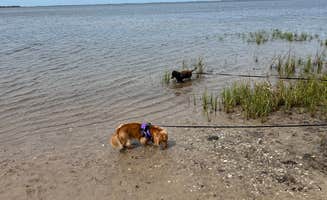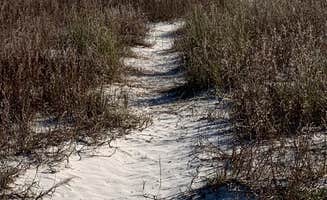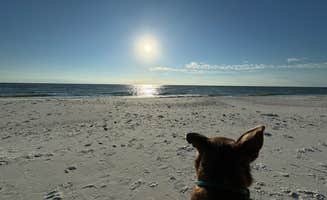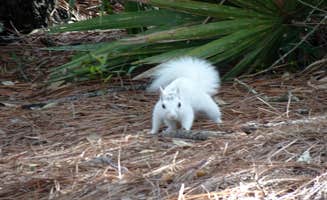Camping options near Apalachicola, Florida range from waterfront state parks to forested primitive sites, all situated in a coastal region where the Apalachicola River meets the Gulf of Mexico. The area's subtropical climate features hot, humid summers with temperatures regularly reaching 90°F and mild winters with occasional frost. Many campsites require advance reservations during peak season from February through April when snowbirds seek warmer winter camping destinations.
What to do
Wildlife watching in Tate's Hell State Forest: Primitive campsites provide access to diverse ecosystems where campers can observe native wildlife. "We saw a few dolphins from a distance and collected some neat shells. It was foggy while we were there, but normally the views on the beach are long range," notes Leah from St. George Island State Park. For nocturnal wildlife viewing, consider camping during meteor showers. "We camped at Pidcock Road Campsite #49 during the 2020 Leonid meteor shower. Nice place for dogs as no other campsites nearby. Very quiet," shares Vince F.
Kayaking and paddleboarding: Launch your watercraft from multiple access points to explore coastal waterways. "The activities on the island are amazing too. There were a couple boat ramps to launch kayaks from, lots of wildlife, a beautiful beach, and the stargazing was phenomenal," reports Becca S. Access points for kayaking are available at most waterfront campsites, though some require a short walk or drive to boat ramps.
Fishing from shorelines or piers: Catch local fish species from designated fishing areas without needing a boat. At Ho-Hum RV Park, "At the end of the fishing pier you can see the crabs clinging to the support poles," notes Paula C. The park includes fishing license coverage for guests using the pier. Shore fishing is particularly productive during early morning or evening hours when fish are most active.
What campers like
Uncrowded beaches: Access to less-developed shorelines provides a more natural beach experience. "If you love the beach the way it use to be this is your place. Miles of bike paths, kayak to your hearts content. During the week you may have times that you are the only one on the beach. Pristine," explains Barbara C. Beach access varies by campground, with some offering direct waterfront sites and others requiring short walks.
Stargazing opportunities: Limited light pollution creates exceptional night sky viewing conditions. "We had a wonderful time at this beautiful primitive campsite. This is not a campground but a private site. The site is located right across the street from the ocean and has a pier you can walk fish from," says Daylin R. about Magnolias by the Bay. The site offers unobstructed ocean views and night sky viewing without interference from nearby development.
Well-maintained facilities: Many campgrounds feature clean, modern amenities despite their relatively remote locations. "The bathhouses were pretty nice as well. Spacious showers and hot water," reports Becca S. At Coastline RV Resort, "Bathrooms are laid out super nice, clean and comfortable," adds Rhonda S. Most established campgrounds provide water and electric hookups, though primitive sites typically offer only basic facilities.
What you should know
Biting insects can be intense: Mosquitoes, no-see-ums, and biting flies are common in this coastal region. "Nats and mosquitos really bad, take bug spray and fans," warns Tammy S. Another camper details, "The only downside to this location was the bugs—definitely recommend mosquito nets and a thermacell. We only stayed one night, but the management did spray for bugs around sunset." Insect activity increases during warmer months and after rainfall.
Limited cell service in remote areas: Connectivity varies significantly across camping locations. At Tate's Hell State Forest High Bluff Primitive Campsites, "There was no cell service on the roads once we entered the dense forest but the spot itself was cleared of trees enough that we got service on ATT and Verizon," reports Laura M. Service is generally better at established campgrounds closer to towns than at primitive sites.
Weather-related challenges: Rain and storms can impact camping conditions significantly. "This is a pretty campground, but in the heart of summer, the mosquitoes and bugs were plentiful. It rained so much that our tent was virtually floating and we had to seek shelter in the bath house," explains Lauren M. Summer thunderstorms are common, often developing quickly in afternoon hours.
Tips for camping with families
Beachcombing activities: Designated shell-collecting areas provide family-friendly entertainment. "We saw a few dolphins from a distance and collected some neat shells," shares Leah. Morning hours typically offer the best shell selection before other beachgoers collect the most interesting specimens.
Bike-friendly paths: Several campgrounds provide cycling opportunities for all ages. "This state park is pristine! I love that the Audubon society works so closely with this park to preserve its fine feathered inhabitants," notes Savannah C. about T.H. Stone Memorial St. Joseph Peninsula State Park. "Sand on the beach is hard packed enough that we were able to ride our bikes right on the beach," adds Laura M., making this an ideal activity even for younger riders.
Wildlife education opportunities: Learning about local ecosystems offers educational value. "This place is great! A beach within a short walk, palm trees, clean bathrooms, wildlife, sunsets... There are hike in spots for those with tents who want to. There are very nice screened in cabins available," shares Richard R. Guided nature programs are sometimes available during peak seasons.
Tips for RVers
Site selection considerations: Choose carefully based on shade and proximity to water. At Indian Pass Campground, "Beautiful location on the water. Campground is just a tad compact when it comes to vehicle maneuverability, but very manageable," advises Matthew V. Most waterfront sites fill quickly, requiring reservations months in advance.
Supply planning: Limited shopping options mean bringing essentials is important. "Bring all necessities because options are limited for shopping in the area and considerably more expensive than normal," cautions T. D. The nearest major grocery stores are in Apalachicola and Port St. Joe, with smaller convenience stores and campground markets offering limited selections at premium prices.
Water and power management: Hookup availability varies significantly between campgrounds. "Each site has water and electric. A dump station is available," notes Chris K. Some primitive sites require self-contained systems, while established campgrounds offer full hookups but may have limitations on amperage.












